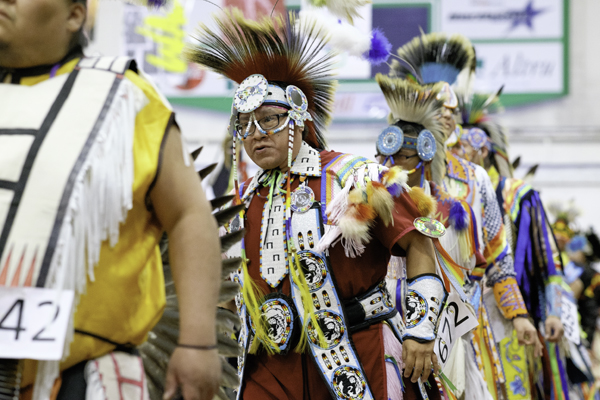48th annual time out wacipi

Dancers process through the Hyslop Sports Center during grand entry of the 48th annual Time Out Wacipi.
April 22, 2018
48 years ago, during a time when Native Americans were still facing large scale racial discrimination. Today, we now enjoy the annual Time Out Wacipi. It’s a five day event of speakers, forums, panels and the main event: a two day powwow.
I attended the powwow with an experienced powwow dancer and attendee, Durana Houle. She helped me understand what was going on as I had never been to a powwow in my life. A powwow is a traditional Native American gathering and was traditionally held for a variety of reasons. Today, they’re held for two different reasons: tradition and competition.
The UND powwow is a competitive event. The dancers can win money for placing and some families will travel to powwows during the summer to earn money. Dancers are judged on their rhythm and regalia. Most of the dancers have the traditional dances passed down to them through their families and learn by watching.
Shenae and Zoee, two of the jingle dress dancers, started that way. Shenae says she “grew up with it through her family.” She now makes her own dresses, does beadwork and travels, still with her family, to powwows all over the country.
“Last month we were in Denver at the powwow there,” Shenae said.
The opportunity to travel is one of her favorite things about powwow dancing since she could walk. She now competes too. She doesn’t sew dresses, but she handmade all of the jingles on the dress used for her style of dance.
“I take a snuff can lid, cut it into a triangle shape, then take a pair of pliers and roll them into their cone shape,” St. Claire said. “It takes a long time, I’d do it while I was watching T.V.”
The regalia they wear comes with a commitment. The drum groups who play the traditional songs for the dancers have a competition too. Judges watch and listen as they drum and sing. Many of the drum groups travel to compete like the dancers do. There is a sense that the music is not just backup for the dancers, but is an art form in its own right.
To open the powwow, there is an event called the Grand Entry. All the dancers, plus some distinguished community members, march and dance into the dance space. Leading them all is a veteran carrying the eagle staff, then veterans carrying national flags.
“Veterans are considered warriors and are very important,” Houle said.
They have extra ceremonial privileges and duties, like warriors traditionally would have. After the honorees, then come all the dancers. There are a number of different styles of dance and each of them have distinct regalia. Some of the male dancers wear bells on their ankles and some of the women have metal pieces called jingles on their dresses, so they add to the music as they dance. Dancing is for all ages, from little tots all the way up. The age groups compete separately, but for certain dances, called intertribals, everyone dances together.
The event is steeped in tradition. Everything has a prescribed order and everything has a meaning. For example, the shawls some of the dancers used were meant to help them imitate butterflies and some dancers will move the opposite direction of everyone else and this is meant to confuse enemies. Often a prayer will be spoken in the tribe’s traditional language and all of the songs they dance to have been passed down traditionally.
A powwow is a celebration of tradition and heritage for Native Americans, but they certainly do not mind anyone else joining in on the fun.
“Everyone is welcome to attend powwows and you could even dance in the intertribals if you wanted to,” Houle said, when I asked if they minded having non Native people, like myself, there.
It’s a celebration of and an opportunity for community and all who are interested are welcome. It’s an experience I would recommend for anyone.
Maddie Ardelean is an A&C writer for Dakota Student. She can be reached at [email protected].

